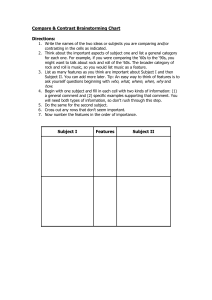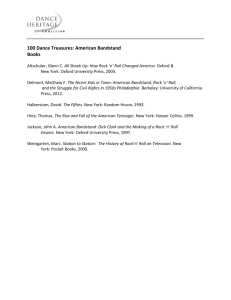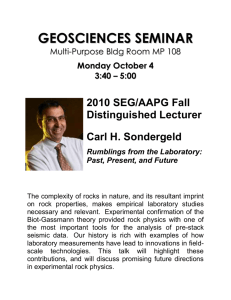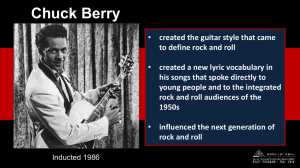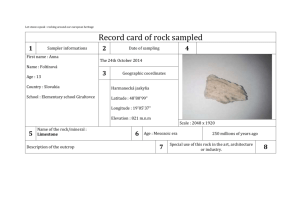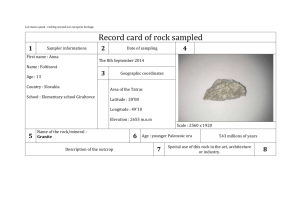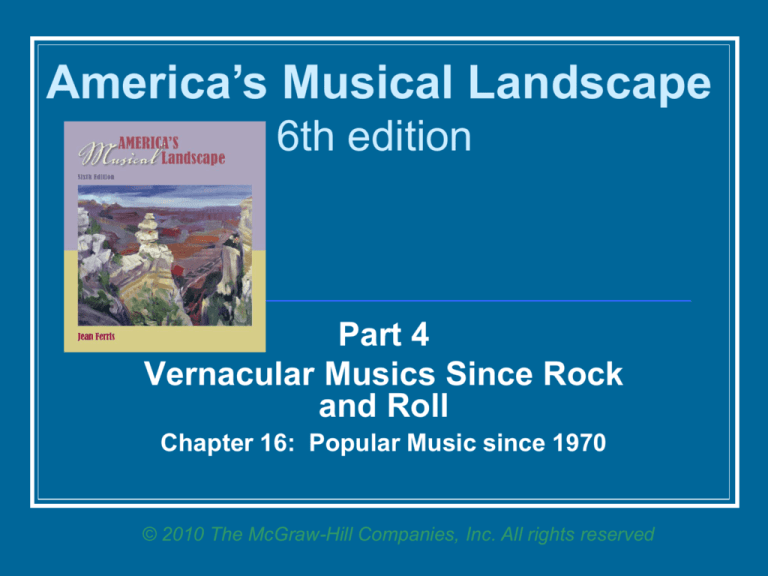
America’s Musical Landscape
6th edition
Part 4
Vernacular Musics Since Rock
and Roll
Chapter 16: Popular Music since 1970
© 2010 The McGraw-Hill Companies, Inc. All rights reserved
Popular Music Since 1970: The
Mood of the Early 1970s
Protest against the Vietnam War
Riots on college campus – Kent State U.
Death of 3 rockers: Jim Hendrix, Janis
Joplin, Jim Morrison
British invasion continued
Rolling Stones became enormously popular
in the USA
© 2010 by The McGraw-Hill Companies, Inc.
All rights reserved.
Part 4: Vernacular Musics Since Rock and Roll
Chapter 16: Popular Music Since 1970
2
Singer-Songwriters
Bruce Springsteen “The Boss” - Wrote songs of
social relevance
Album Born in the USA
Film Philadelphia (1995) with songs by Bruce Springsteen
Joni Mitchell
Sang of her own experience using blues, rock and folk
styles
Ever-changing interests from nature to narrative to
political indignation
© 2010 by The McGraw-Hill Companies, Inc.
All rights reserved.
Part 4: Vernacular Musics Since Rock and Roll
Chapter 16: Popular Music Since 1970
3
Art Rock
Rockers and jazz musicians collaborate
and incorporate music of other styles and
cultures
Blood, Sweat and Tears – Rock Quartet
Chicago – Used some jazz elements
Emerson Lake & Palmer – related jazz to
classical music
Moody Blues – Produced an art rock album with
the London Festival Orchestra in 1967
© 2010 by The McGraw-Hill Companies, Inc.
All rights reserved.
Part 4: Vernacular Musics Since Rock and Roll
Chapter 16: Popular Music Since 1970
4
Disco
Began as “discothèque” in France after World War II
First American discothèques opened in America in 1960 with elitist
membership requirements
Led to dance crazes including
the Twist, the Jerk, the Watusi
1970s – Re-launched as “disco” and
became a popular dance phenomenon
Film Saturday Night Live (1977)
© 2010 by The McGraw-Hill Companies, Inc.
All rights reserved.
Part 4: Vernacular Musics Since Rock and Roll
Chapter 16: Popular Music Since 1970
5
Punk
Born in the small New York bar, CBGB & OMFUG
New York Dolls – Punk group premiered at this bar
Characteristics include:
Association with the art world
Narrow vocal range; drone-like
Rigid eighth-note rhythm throb
Influence of fashion, performance
art, shock value
Pounding beat
Heavy guitar distortion
© 2010 by The McGraw-Hill Companies, Inc.
All rights reserved.
Part 4: Vernacular Musics Since Rock and Roll
Chapter 16: Popular Music Since 1970
6
Punk Bands
Television – a punk band attracted to the art of
Andy Warhol and the Velvet Underground , and to
the jazz improvisation of John Coltrane
Patti Smith – A professional writer of poetry, plays
and articles. Had a vocal and delivery style
intended to shock
Ramones – Projected fun, spirit, raw energy
© 2010 by The McGraw-Hill Companies, Inc.
All rights reserved.
Part 4: Vernacular Musics Since Rock and Roll
Chapter 16: Popular Music Since 1970
7
New Wave
New Wave groups defused punk by imitating its manner but not its
substance
New Wave – a philosophy of life expressed through new or
progressive music
Talking Heads
B-52s
Cars
Police
© 2010 by The McGraw-Hill Companies, Inc.
All rights reserved.
Part 4: Vernacular Musics Since Rock and Roll
Chapter 16: Popular Music Since 1970
8
Grunge
Grunge – refers to a style adopted by teenagers of the 1990s –
Generation X
Originating n the Northwest, grunge sometimes called the Seattle
sound
Combined the aggression of heavy metal with a melodic
element reminiscent of the Beatles
Nirvana – Grunge band led by Kurt Cobain
Pearl Jam
© 2010 by The McGraw-Hill Companies, Inc.
All rights reserved.
Part 4: Vernacular Musics Since Rock and Roll
Chapter 16: Popular Music Since 1970
9
Electronic Dance Music
Use of synthesizers and
other electronic instruments
Varied sonorities of live
and recorded music
2001 – Disco and new wave
underwent a dance floor revival
Electronic timbres reflected everyday sounds such as phones, cash
machines, alarms
Also called house, techno, electro, nu-wave
© 2010 by The McGraw-Hill Companies, Inc.
All rights reserved.
Part 4: Vernacular Musics Since Rock and Roll
Chapter 16: Popular Music Since 1970
10
Pop Music and Politics
Early 1960s and 1970s – Peak of political pop music
Controversies over Civil Rights and the Vietnam War inspired
protest songs heard widely on pop and rock radio stations
Bob Dylan - “The Times They Are a-Changin’”
Buffalo Springfield - “For What It’s Worth”
Marvin Gaye - “What’s Goin’ On?”
Since then, mainstream music has generally been more concerned
with having a good time
In 2004, pop musicians were again motivated to take political
stands
Against the wars in Iraq and Afghanistan
Urging people to vote in the upcoming election
© 2010 by The McGraw-Hill Companies, Inc.
All rights reserved.
Part 4: Vernacular Musics Since Rock and Roll
Chapter 16: Popular Music Since 1970
11
Looking Forward, Backward, and
Abroad
Concerts and recordings achieve new levels of
sophistication with new technology
Improved communication and expanded travel
bring new sounds to the Western vernacular
music experience
Collaborations involving dead artists are popular
Musicians can now hear music from other nations and
incorporate it into their own work with ease
A the same time, many rock musicians have
returned to their roots
Nostalgia for earlier familiar sounds vies with the urge to
explore new music
© 2010 by The McGraw-Hill Companies, Inc.
All rights reserved.
Part 4: Vernacular Musics Since Rock and Roll
Chapter 16: Popular Music Since 1970
12
Hip-Hop and Rap
South Bronx, New York in the 1970s
A neighborhood in ruin
Jobless, poor and hopeless urban conditions spawned hip-hop
culture
B-boying - break dancing
Graffiti writing – spray can painting
DJing – disc jockeys playing and manipulating records at parties
MCing – a master of ceremonies raps over recordings
Afro-American, Afro-Caribbean and Latino families arrive
Increase in gang violence as newcomers and remaining whites clash
Hip-hop culture came to the Bronx out of Jamaica
Rapping over spinning records derived from reggae
© 2010 by The McGraw-Hill Companies, Inc.
All rights reserved.
Part 4: Vernacular Musics Since Rock and Roll
Chapter 16: Popular Music Since 1970
13
Reggae
During 1960s, following their recent independence
from Great Britain, Jamaican youth created a
new, hybrid music called Reggae
Harmonically simple, socially conscious
Drew from global popular culture to express
national pride
© 2010 by The McGraw-Hill Companies, Inc.
All rights reserved.
Part 4: Vernacular Musics Since Rock and Roll
Chapter 16: Popular Music Since 1970
14
Reggae
Reggae fused elements of North American rock
and African Jamaican music to form a kind of
“acculturated rock”
1960s—popular in England
1970s—popular in the United States
Bob Marley (1945-1981) was a leading performer who
became famous in the United States
© 2010 by The McGraw-Hill Companies, Inc.
All rights reserved.
Part 4: Vernacular Musics Since Rock and Roll
Chapter 16: Popular Music Since 1970
15
Reggae
Reggae comes in several styles, all roughly
related to rhythm and blues
Reggae combos consist of
But the polyrhythms are more complex
Bass lines stronger
Tempos more relaxed
Electric guitars, electric organ, electric bass
guitar, drums
Electronic studio techniques
Toasting or Dubbing = rapid patter talking,
to influence development of rap music
Electric guitar
© 2010 by The McGraw-Hill Companies, Inc.
All rights reserved.
Part 4: Vernacular Musics Since Rock and Roll
Chapter 16: Popular Music Since 1970
16
Reggae:
Religious and Spiritual Implications
Reggae—a vernacular music (rock) borrowed and
transformed by a culture (Jamaican) other than
the one that introduced it (African American) to
form a new style
Represents a popular music with strong religious connotations
Rastafarianism = a black religious movement
Many of the songs have urgent political content
Promoting the 1960s “back to Africa” movement
© 2010 by The McGraw-Hill Companies, Inc.
All rights reserved.
Part 4: Vernacular Musics Since Rock and Roll
Chapter 16: Popular Music Since 1970
17
The Rise of Hip-Hop
Jamaicans immigrating to the South Bronx in the 1960s
brought sophisticated turntable techniques
DJs developed outstanding performance techniques
In Kingston, mobile sound systems had largely replaced live bands
A DJ could bring dance parties to street crowds with only a turntable,
amplifiers and speakers
Backspinning, altering playing speeds, scratching
DJs played many kinds of music including R&B hits, reggae
© 2010 by The McGraw-Hill Companies, Inc.
All rights reserved.
Part 4: Vernacular Musics Since Rock and Roll
Chapter 16: Popular Music Since 1970
18
The Rise of Hip-Hop
Scratch DJs, also known as turntablists, have become artists
in their own right
The turntable may be the most important musical instrument
of the current era
The music heard in dance clubs today is often the creation of
a DJ
Sample-based
Electronically composed
Current styles include drum-and-bass, house, trip-hop
© 2010 by The McGraw-Hill Companies, Inc.
All rights reserved.
Part 4: Vernacular Musics Since Rock and Roll
Chapter 16: Popular Music Since 1970
19
Rap
At 1970s South Bronx street turntable shows, DJs hired MCs
(masters of ceremonies) to fire up the crowd
When MCs began speaking over the rhythm of the music and
trading rhymes with each other and the DJ, rap was born
Rap draws from many sources
African, Afro-Caribbean, and African-American rhythmic styles
Urban street jive
Black radio DJs, Public personalities
© 2010 by The McGraw-Hill Companies, Inc.
All rights reserved.
Part 4: Vernacular Musics Since Rock and Roll
Chapter 16: Popular Music Since 1970
20
Rap
1970s – Rappers and DJs preserved their performances on
mixtapes = homemade tapes made at street dances and
club shows
1979 – The independent label Sugar Hill Records auditioned
three unknown rappers and signed them to improvise the
recording “Rapper’s Delight”
Became a world-wide hit
DJs found that dancers preferred the recording to a live DJ
© 2010 by The McGraw-Hill Companies, Inc.
All rights reserved.
Part 4: Vernacular Musics Since Rock and Roll
Chapter 16: Popular Music Since 1970
21
Listening Example 58
“Rapper’s Delight”
quickly reached the
American Top 40,
introducing America and
the world to hip-hop
music.
Rapper’s Delight (excerpt)
Improvised by The Sugarhill Gang:
Henry “Big Bank Hank” Jackson, Guy “Master Gee” O’Brien, and
Michael “Wonder Mike” Wright
Listening Guide on page 283
Form: Strophic. Each of the three rappers improvises a “verse,”
performing a recitation over the background music
Meter: Duple, with a heavy backbeat
Text: The rappers brag about themselves, describe dance moves, tell
funny stories and exhort the listeners to respond
© 2010 by The McGraw-Hill Companies, Inc.
All rights reserved.
Part 4: Vernacular Musics Since Rock and Roll
Chapter 16: Popular Music Since 1970
22
Social Concerns
Hip-hop: culture or craft?
White rappers claimed that hip-hop can be learned, regardless of ethnic or
cultural heritage
Some black hip-hop musicians claim that hip-hop is a culture that one must
be born into
“Gangsta rap” of the late 1980s often praised misogyny and
violence
Attracted devoted listeners
Drew condemnation from officials due to violent lyrics
Lyrics alternating tenderness and brutality
© 2010 by The McGraw-Hill Companies, Inc.
All rights reserved.
Part 4: Vernacular Musics Since Rock and Roll
Chapter 16: Popular Music Since 1970
23
Back to the Roots
Some rappers produce lighthearted, playful songs
Rap artists appeared on mainstream television and in films
1990s rap-based cartoons appeared on television
Will Smith
Ice Cube
Urban rappers draw on earlier black music sources
Kirk Franklin – melds hip-hop and traditional gospel
Sean Combs (P. Diddy) – references earlier artists
© 2010 by The McGraw-Hill Companies, Inc.
All rights reserved.
Part 4: Vernacular Musics Since Rock and Roll
Chapter 16: Popular Music Since 1970
24
Music Business
New technologies continually alter the business of music
Popularity of home recording studios
Now possible to create, perform, record and market music from home
Individual musicians can simulate a combo or singing group
E-jamming software allows independent musicians to play and record with
musicians via Internet connection
Studio sound engineers practice sophisticated sonic
manipulation
As products and processes become outdated, new
possibilities evolve
© 2010 by The McGraw-Hill Companies, Inc.
All rights reserved.
Part 4: Vernacular Musics Since Rock and Roll
Chapter 16: Popular Music Since 1970
25
Music Business: Sharing Music
1999 – fans could share and swap music files for free via the
Internet using software program Napster
Music industry felt negative impact
Legal challenges forced Napster to close its free service
2001 – portable digital audio player called the iPod
revolutionized the music business
Interface between the iPod and Apple’s online iTunes Store
Downloading music becomes quick, easy and affordable
Napster eventually establishes for-pay system
© 2010 by The McGraw-Hill Companies, Inc.
All rights reserved.
Part 4: Vernacular Musics Since Rock and Roll
Chapter 16: Popular Music Since 1970
26
Music Business: Sharing Music
Music purchased from the iTunes Store subject to a digital
rights management [DRM] system
An effort to prevent the music from being played on unauthorized devices
2009 – looking for alternatives to DRMs, since they weren’t sufficiently
effective
Digitized music is easily shared on the Internet – legally and
illegally
Some people support copyright protection
Others believe that consumers should be able to share, remix and reuse
music
CD sales quickly decline
© 2010 by The McGraw-Hill Companies, Inc.
All rights reserved.
Part 4: Vernacular Musics Since Rock and Roll
Chapter 16: Popular Music Since 1970
27
Music Business: Marketing Music
Traditionally, artist’s careers were launched and controlled by
commercial labels
In 2008, Atlantic Records reported that more than half of its
music sales in the United States were from digital products
“Multiple rights” or “360” deals as a response to declining
sales
Label shares earnings from recordings, live concerts, merchandise
Label increases investment in marketing and developing the artist’s career
© 2010 by The McGraw-Hill Companies, Inc.
All rights reserved.
Part 4: Vernacular Musics Since Rock and Roll
Chapter 16: Popular Music Since 1970
28
Music Business: Marketing Music
Today some musicians bypass commercial labels by
recording for independent companies
Corporate-owned radio stations generally do not play music from smaller
labels
The Internet provides opportunities for music produced by independent
labels to be heard world-wide
Blogs, artist websites, MySpace and Facebook
The Internet offers unprecedented opportunities for the
marketing of independently produced music
Blogs, artist websites, MySpace, Facebook
Some artists offer free downloads and consumer pricing
© 2010 by The McGraw-Hill Companies, Inc.
All rights reserved.
Part 4: Vernacular Musics Since Rock and Roll
Chapter 16: Popular Music Since 1970
29
Music Business: Marketing Music
Music has become democratized
Free from the demands and manipulation of big-name commercial
companies
Free from the need to become commercially successful
Now diverse, experimental music – unacceptable to Top 40
venues – can find welcome, and generate income, on the
Internet
The business of music continues to evolve
Technology, multiculturalism and the accomplishments of
previous generations of pop musicians have created a pop
scene that is richer and more varied than ever before
© 2010 by The McGraw-Hill Companies, Inc.
All rights reserved.
Part 4: Vernacular Musics Since Rock and Roll
Chapter 16: Popular Music Since 1970
30
Part 4 Summary: Rock and Roll
In the 1950s, white country-western music combined with
elements of black rhythm and blues to produce rock and roll
Driven by the tastes of American teens
Featured white country singers with a black style of delivery
Motown produced records by black artists that appealed to a
white audience
Soul brought music of a new intensity to rock and roll
The British invasion
© 2010 by The McGraw-Hill Companies, Inc.
All rights reserved.
Part 4: Vernacular Musics Since Rock and Roll
Summary
31
Part 4 Summary: Rock Flirts with
Country
The urban folk movement reflected continuing relationships
between rock and country
Bob Dylan, Joan Baez, and others composed and performed
folklike songs on topical subjects
Alternative country rivals the polished sounds of commercial
country music
Blends punk and rock and roll effects with country sounds
© 2010 by The McGraw-Hill Companies, Inc.
All rights reserved.
Part 4: Vernacular Musics Since Rock and Roll
Summary
32
Part 4 Summary: Jazz Since 1960
Jazz in the later part of the twentieth century explored new
and increasingly complex musical concepts
Free jazz declared independence from most preconceived
notions about jazz
Focus on collective improvisation
Fusion melds jazz and rock
Jazz musicians integrate foreign sounds into their music
Jazz composition is again an important field of American
music
© 2010 by The McGraw-Hill Companies, Inc.
All rights reserved.
Part 4: Vernacular Musics Since Rock and Roll
Summary
33
Part 4 Summary: Popular Music
Since 1970
Punk, new wave, and grunge addressed social concerns in
the late twentieth century
New technologies impact
the creation of popular music
the marketing music
the consumption of music
Hip-hop culture, derived from Jamaican and African
influences, evolved in the South Bronx
Popularity quickly spread
Rap artists and DJs became increasingly virtuosic
© 2010 by The McGraw-Hill Companies, Inc.
All rights reserved.
Part 4: Vernacular Musics Since Rock and Roll
Summary
34

